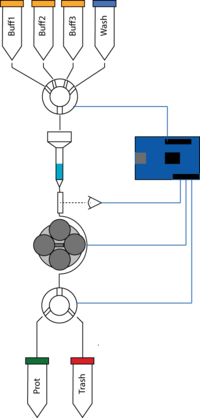APPS
Objective and context
In laboratory, routine tagged-protein (His or strep tagged proteins) purification is usually made manually with the the help of resins. This procedure is often, so to say, boring and repetitive. Automatic alternatives exist but are costly (8000 - 15000), bulky and often too specific for such simple but long task. The idea is to develop a small, (semi-)automatic, cheap(er) and modulable protein purification system for most of the routine task.
Routine Protein Purification
In the world of protein engineering, enzymology, drug development and synthetic biology, amounts of pure proteins are required to study and evaluate the potential of an enzyme to be a candidate for future development. One routine example of protein production and purification would be the following: A bacterial strain is transfected with a plasmid containing the protein of interest (POI) tagged at its C and N termini with His and Strep tags. The POI would be expressed by the strain (i.e. e.coli) in liquid culture. The bacteria in the cultures would by lysed and the homogenate purified. A usual purification would involve to prepare a column and pack it with a resin such as the His purification resin. The column would be (i) equilibrated with a first buffer, (ii) the homogenate would be slowly passed through the column, (iii) a second buffer would be flown through the column to remove all the remaining unwanted bacterial debris. All these step are made with the help of a peristaltic pump to apply suction but the performer has to stay by the system to ensure that the resin never becomes dry. (iv) A last buffer would be used to unblock the protein from the resin and collect it in a gravity dependent manner. These purification steps will be then performed again with a second type of resin to ensure total purity of the protein.
This procedure occupies a large amount of the time of a scientist and could be in this way automatized.
System design
Schematically the system would be composed of several modules: A buffer holder where several 50ml tubes can be stored, a column holder where various sets of columns could be fitted, a 280 LED based optical cell, a peristaltic pump, a simple trash/sample collection system and a controller (Arduino or Raspberry Pi) + display.
UV system
The UV system will be composed of 280 emitting LED and a UV detector. The optical chamber will be
Several European and American providers exist but propose prices that are way above reasonable price for such LEDs.
The following providers were investigated. (accessed 08.2015)
| Provider | prices | links | Comment |
|---|---|---|---|
| Roithner lasers | Expensive | link1, link2 | |
| Intl UV LEDs | Around 34.5 $ / LED | link | |
| ThorLab | Expensive | link | |
| Seoulviosys | Expensive | link | |
| Qphotonics | Expensive | link | |
| TME | Around 20/LED (can buy single ones) | link | three units were ordered here Datasheet |
| Alibaba | - - - | link | Company verified, 6yr business, Iso compliant. |
| Taobao | 1.20.- per LED | link | 280nm , 0.5 - 30. mW |
| Ledwv | - - - | link |
